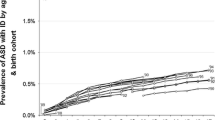Abstract
Prevalence statistics for autism spectrum disorders (ASD) vary widely across geographical boundaries. Some variation can be explained by diagnostic methods, case ascertainment and age at diagnosis. This study compared prevalence statistics for two distinct geographical regions, Denmark and Western Australia, both of which have had population-based registers and consistent classification systems operating over the past decade. Overall ASD prevalence rates were higher in Denmark (68.5 per 10,000 children) compared with Western Australia (51.0 per 10,000 children), while the diagnosis of childhood autism was more prevalent in Western Australia (39.3 per 10,000 children) compared with Denmark (21.8 per 10,000 children). These differences are probably caused by local phenomena affecting case ascertainment but influence from biological or geographical factors may exist.


Similar content being viewed by others
References
American Psychiatric Association. (1994). Diagnostic and statistical manual of mental disorders IV (4th ed.). Washington DC: American Psychiatric Association.
American Psychiatric Association. (2000). Diagnostic and statistical manual of mental disorders IV-TR. Washington DC: American Psychiatric Association.
Baron-Cohen, S., Scott, F. J., Allison, C., Williams, J., Bolton, P., Matthews, F. E., et al. (2009). Prevalence of autism-spectrum conditions: UK school-based population study. British Journal of Psychiatry, 194, 500–509.
Blaxill, M. F. (2004). What’s going on? The question of time trends in autism. Public Health Reports, 119, 536–551.
Centers for Disease Control and Prevention. (2009). Autism and developmental disabilities monitoring network surveillance year 2006 principal investigators. Prevalence of autism spectrum disorders—autism and developmental disabilities monitoring network, United States, 2006. Morbidity and Mortality Weekly Report. MMWR. CDC Surveillance Summaries, 58, 1–20.
Fombonne, E. (2005). Epidemiology of autistic disorder and other pervasive developmental disorders. Journal of Clinical Psychiatry, 66(Suppl 10), 3–8.
Fombonne, E. (2009). Epidemiology of pervasive developmental disorders. Pediatric Research, 65, 591–598.
Gardener, H., Spiegelman, D., & Buka, S. L. (2009). Prenatal risk factors for autism: Comprehensive meta-analysis. British Journal of Psychiatry, 195, 7–14.
Glasson, E. J. (2002). The Western Australian register for autism spectrum disorders (Letter). Journal of Paediatrics and Child Health, 38, 321.
Glasson, E. J., & Wray, J. (2004). Obtaining consent affects the value of the Western Australian autism register. Medical Journal of Australia, 181, 514–515.
Glasson, E. J., MacDermott, S., Dixon, G., Cook, H., Chauvel, P., Maley-Berg, A., et al. (2008). Management of assessments and diagnoses for children with autism spectrum disorders: The Western Australian model. Medical Journal of Australia, 188, 288–291.
Mandell, D. S., Novak, M. M., & Zubritsky, C. D. (2005). Factors associated with age of diagnosis among children with autism spectrum disorders. Pediatrics, 116, 1480–1486.
Munk-Jorgensen, P., & Mortensen, P. B. (1997). The Danish psychiatric central register. Danish Medical Bulletin, 44, 82–84.
Nassar, N., Dixon, G., Bourke, J., Bower, C., Glasson, E., de Klerk, N., et al. (2009). Autism spectrum disorders in young children: Effect of changes in diagnostic practices. International Journal of Epidemiology, 38, 1245–1254.
Parner, E. T., Schendel, D. E., & Thorsen, P. (2008). Autism prevalence over time: The confounding of changes in age at diagnosis. Archives of Pediatrics and Adolescent Medicine, 162, 1150–1156.
Petterson, B., Leonard, H., Bourke, J., Sanders, R., Chalmers, R., Jacoby, P., et al. (2005). IDEA (Intellectual Disability Exploring Answers): A population-based database for intellectual disability in Western Australia. Annals of Human Biology, 32, 237–243.
Stanley, F. J., Croft, M. L., Gibbins, J., & Read, A. W. (1994). A population database for maternal and child health research in Western Australia using record linkage. Paediatric and Perinatal Epidemiology, 8, 433–447.
World Health Organization. (1992). The ICD-10 classification of mental and behavioural disorders. Geneva: World Health Organization.
Acknowledgments
This research was supported by Autism Speaks, New York, USA (Grant #2561).
Author information
Authors and Affiliations
Corresponding author
Rights and permissions
About this article
Cite this article
Parner, E.T., Thorsen, P., Dixon, G. et al. A Comparison of Autism Prevalence Trends in Denmark and Western Australia. J Autism Dev Disord 41, 1601–1608 (2011). https://doi.org/10.1007/s10803-011-1186-0
Published:
Issue Date:
DOI: https://doi.org/10.1007/s10803-011-1186-0




